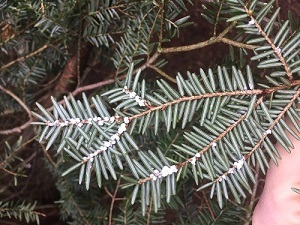|
For immediate release: March 18, 2024
Media contact: Jennifer Holton, 517-284-5724
Program contact: Rob Miller, 517-614-0454?
LANSING ? The Michigan Department of Agriculture and Rural Development recently verified a new detection of invasive hemlock woolly adelgid near Torch Lake in western Antrim County. The extent of the infestation has not yet been determined, but an extensive survey of the surrounding area is underway. With this new detection, Antrim becomes the seventh county in the state with an active hemlock woolly adelgid infestation, joining Allegan, Benzie, Mason, Muskegon, Oceana, Ottawa, and Washtenaw counties.
?The new infestation was found by a landowner who learned about the hemlock woolly adelgid while attending an educational outreach event held by the Cooperative Invasive Species Management Area that serves Charlevoix, Antrim, Kalkaska, and Emmet Counties,? said Steve Carlson, MDARD?s Pesticide and Plant Pest Management Division Director. ?Situations like this demonstrate the importance of public awareness in our fight against invasive species.?
Hemlock woolly adelgids are small insects that use their long, siphoning mouthparts to extract sap from hemlock trees. Their feeding weakens needles, shoots, and branches. Over time, tree growth slows, and trees take on a grayish-green appearance. Without treatment, infested trees die within four to 10 years.

?If left unchecked, hemlock woolly adelgid can cause significant harm to Michigan?s estimated 170 million hemlock trees,? added Carlson.
Hemlock woolly adelgid can be identified by looking on the undersides of hemlock branches for evidence of round, white ovisacs near the base of the needles. Up close, ovisacs look like balls of spun cotton and may appear alone or in clusters. The short video Hemlock Woolly Adelgid: Invasive Species in Michigan provides helpful identification tips.
|
Other, less damaging pests easily can be mistaken for hemlock woolly adelgid. Be sure to review photos and descriptions of common hemlock woolly adelgid look-alikes at Michigan.gov/HWA. Help in identifying eastern hemlock trees is also available at the same site.
?Hemlock woolly adelgid likely arrived in Michigan on infested nursery stock from northeastern states. Though the tiny insects don?t move far on their own, they can be blown by wind or hitchhike on animals. In a similar way, cars, boats, or RVs parked under infested trees may be able to transport the insects to new locations,? said Carlson. ?If you?re headed outdoors, take simple measures like only parking in designated areas and cleaning your gear and vehicle before traveling. Also, remember to leave firewood at home and buy it locally at your destination.?
Suspected infestations in Antrim County or new areas of the state can be reported by:
Be prepared to report the location of infested trees and, whenever possible, take one or two pictures of infested branches to help confirm identification. To avoid spreading hemlock woolly adelgid, do not collect sample branches or twigs.
For more information on hemlock woolly adelgid and other invasive species in Michigan, and to find out what you can do to help prevent them, visit Michigan.gov/Invasives.
Michigan's Invasive Species Program is cooperatively implemented by the Department of Environment, Great Lakes, and Energy; the Department of Natural Resources; and the Department of Agriculture and Rural Development.
Note to editors: Accompanying photos are available below for download. Caption information follows.?
Infested branch: Round, white hemlock woolly adelgid ovisacs are found on the undersides of branches near the base of the needles.
Hemlock branch: Hemlock trees have small, papery cones and short needles that are dark green on top.
|